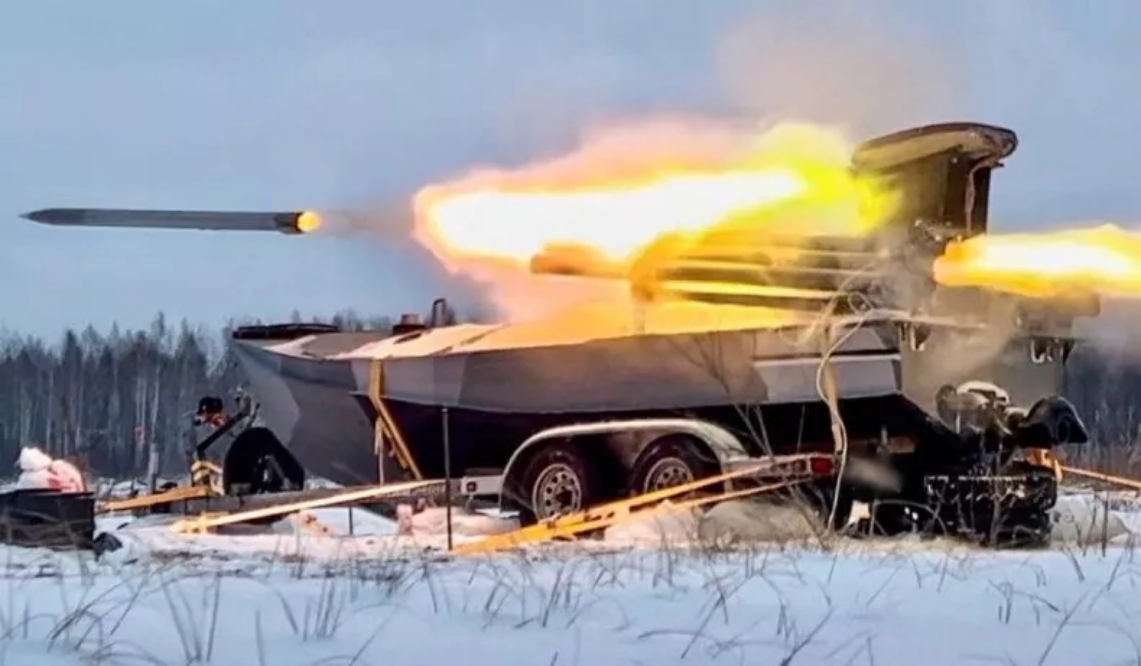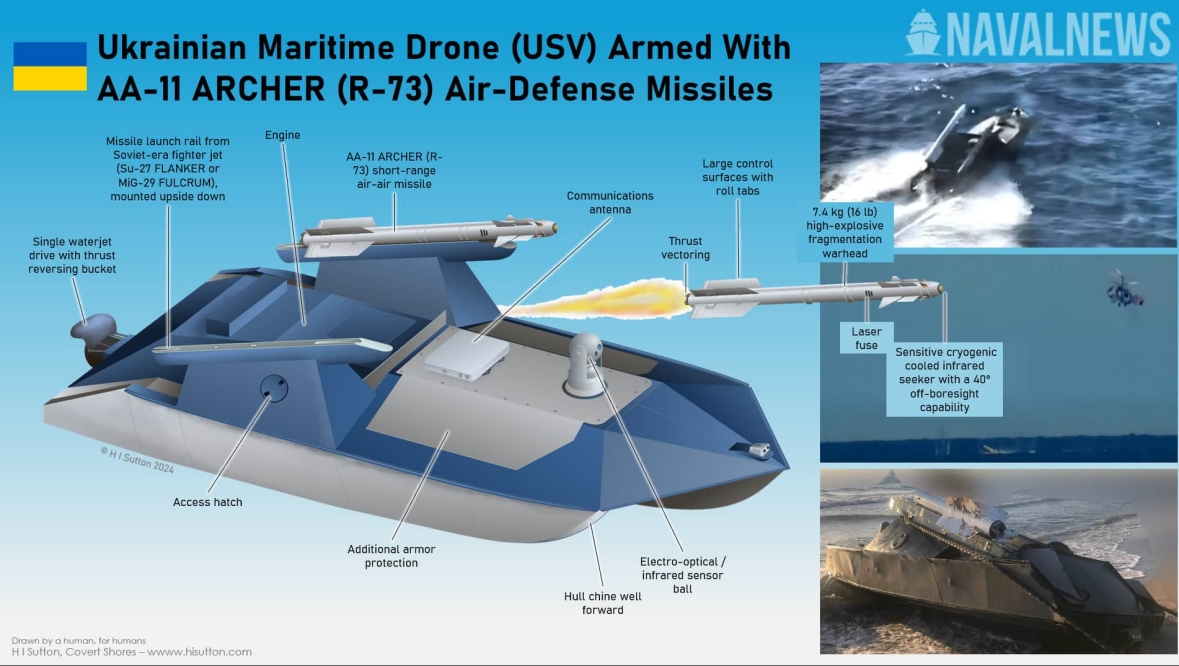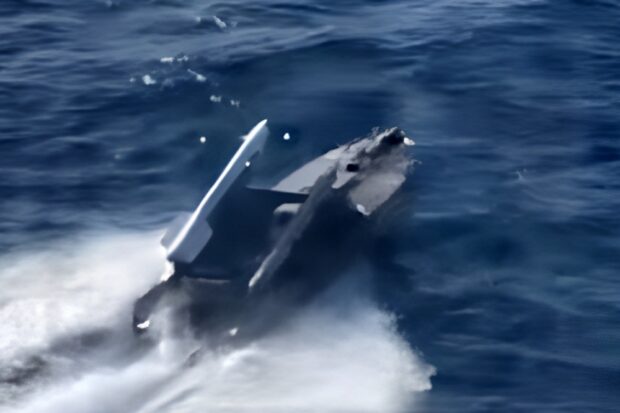Ukraine’s uncrewed surface vessels (USVs) are dominating naval combat in the Black Sea. Yet they have, until now, been particularly vulnerable to aircraft. So Russian defenses have emphasized using helicopters and fighter jets to stop them. Now a version armed with two repurposed air-air missiles could change the tide again.
The war in Ukraine has removed any remaining doubts that drones are transforming warfare. In the naval arena, Ukraine’s maritime drones are leading the world in terms of combat application. These explosive-laden craft first challenged, and then changed, many preconceptions. Now Ukraine has deployed an entirely new category of maritime drone, one armed with air defense missiles.
Until now Ukraine’s maritime drones (USVs) have been most vulnerable to aircraft. They are essentially defenseless against a helicopter armed with a machinegun. Now, with some USVs armed with potent air-defense missiles, Russian pilots may think twice about approaching them.
In practice this is the first such air-defense USV in the world. Other country’s manufacturers have explored giving USVs some form of air defense. But this system is the first fielded operationally, and indeed, the first in combat.

An image of an adapted Ukrainian Sea Baby drone. The SBU, Ukraine’s state security service, is already using modified Sea Baby naval drones fitted with Soviet-era Grad multiple rocket launchers against Moscow’s forces
The Drone is Armed with Two Missiles
The new USV (uncrewed surface vessel) is distinct from previously observed types, featuring a new wider hull. This allows two missiles to be carried side-by-side.
It is armed with two R-73 air-air missiles. This parallels a trend on land with Ukraine increasingly leveraging missiles designed for one system on another. At least one vintage Osa air-defense system has also been equipped with R-73s, and British supplied ASRAAMs have also been used as ground-based systems. These mix-match systems are informally termed ‘FrankenSAMs’ after Frankenstein’s monster. All the same these missiles now allow the vessel to pose a real threat to aircraft.
The R-73 missile, known by the NATO reporting name AA-11 Archer, is a Soviet-era short-range air-air missile. Carried by fighters like the MiG-29 Fulcrum and Su-27 Flanker, the missile was arguably the best dogfighting missile in service. It was highly agile and had an impressive seeker with 40 degrees off-boresight capability. This meant that it could be launched against a target with was not directly in front of the plane. And to air targeting, the seeker was slaved to a helmet mounted sight.
In the 1980s this was more advanced than the equivalent NATO. Today the latest versions of the Sidewinder, or the ASRAAM, IRIS-T, are arguably more potent. But the R-73 remains a potent system.
The trade-off for surface launch will be range. Even if the vessel can detect the aircraft at range, the missile itself will have around half the range compared to if it was air launched. For the R-73 this means a range of around 15 km (9 miles). In practice, the detection range of the vessels’ electro-optical devices is likely to be the main limitation.

Click To Enlarge: The vessel is armed with two R-73 (AA-11 Archer) missiles. This should allow it to engage aircraft at ranges of up to 15 km (9 miles) although realistic engagements may be shorter
Videos from the Black Sea recently depict a Kamov Ka-29 helicopter circling a Ukrainian unmanned surface vehicle—either a 19-foot Sea Baby or a slightly smaller Magura—before peppering it with gunfire.
The helicopter-on-drone engagement might be related to a recent Ukrainian drone boat raid on the Black Sea Fleet in Crimea. The boats reportedly struck and sank a Russian patrol craft.
It wasn’t the first time a Russian aircraft had destroyed a Ukrainian USV. But that particular USV was notable for its top-mounted twin missile rails—and the 10-foot R-73 infrared-guided dogfighting missile fitted to one rail. It seems some Ukrainian USVs are traveling with their own air-defense missiles.
The Russian Fighterbomber Telegram channel expressed surprise. “The Ukrainian were able to somehow connect the rocket with the USV’s telecontrol systems.”
An R-73’s seeker is sensitive to heat sources such as an aircraft engine; it doesn’t need telemetry from the launching vehicle for guidance. But Fighterbomber isn’t wrong to wonder exactly how the USV’s crew would remotely aim and launch an R-73.
Fighterbomber speculated that Ukrainian drone boats haven’t yet fired their air-defense missiles in anger. But it’s worth noting that the USV the Kamov crew gunned down had two missile rails, but only one rail had a missile on it.
By fitting R-73s to USVs, Ukrainian forces add yet another role to their increasingly versatile drone boats. Most of Ukraine’s USVs are one-way attack craft: packed with explosives, they ram into Russian warships. There’s also a version of the Sea Baby that can fire unguided rockets for stand-off attacks. It’s possible the largest Ukrainian USV type also carries a radio jammer.
There’s an outside chance the air-defense USVs have already scored their first aerial kill. At least one, and possibly two, Russian helicopters got into trouble over the Black Sea on April 9 and 10. Ukrainian navy spokesman Dmytro Pletenchuk claimed a Kamov Ka-27 crashed on April 9. Multiple sources confirmed a second helicopter, a Mil Mi-24, crashed on April 10.
The Kamov crash is unconfirmed. But what’s interesting is Pletenchuk’s claim that the rotorcraft had “been looking for something” and “found it.” If the Russians did lose a Ka-27 on April 9 and that helicopter was out searching for USVs, did it find a USV armed with surface-to-air missiles?
Potential Roles and Impact
The missiles provide the drone with a degree of self-protection. The craft is now better defend itself against Russian helicopters and fast jets. One or two of the FrankenSAM USVs mixed in with a larger force of regular USVs may be enough to inhibit Russian attempts to interdict them.
The system also opens the possibility of using them to ambush Russian aircraft as they take-off or land on Crimean air bases. The USVs can sit off the Crimean coast and pick off the aircraft as they approach unawares. There is at least circumstantial evidence to suggest that this may have already been done.
Many USVs manufacturers around the world are already emulating Ukrainian advances. And there have been several proposals for air defense equipped types even before the Russo-Ukraine War. But the emergence of this type, and its apparent utility, is likely to make those proposals be taken more seriously.
Sources: Forbes; Naval News

